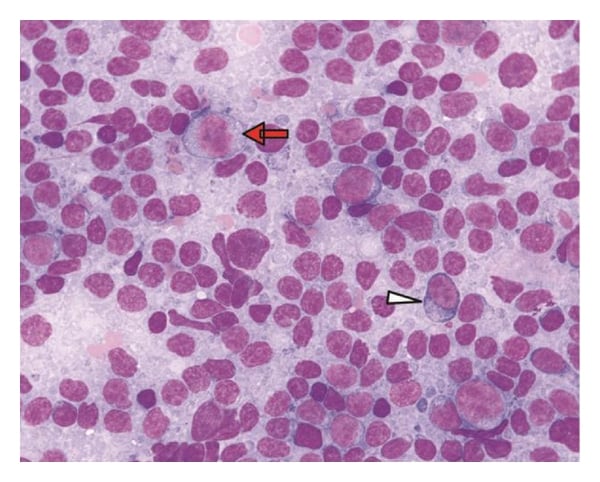Lymphomas are malignancies arising in the lymph nodes and other lymphoid tissues. They can be broadly divided into Hodgkin’s (HD) and Non-Hodgkin’s lymphomas (NHL). HD are characterized by the presence of Reed-Sternberg cells. NHL is more common than HD and does not show Reed-Sternberg cells. B cell NHL is more common than T cell NHL.
| Type | Features |
| Diffuse large B cell lymphoma | Most common NHL, commonly seen in the chest, neck, armpit, abdomen, associated with HIV, EBV; shows diffuse, large malignant lymphoid cells. |
| Follicular lymphoma | Associated with t (14;18), overexpression of anti-apoptotic bcl2; more common in adults, appears as malignant follicles typically with lack of mantle zone, uniformly filled with malignant lymphoid cells with loss of lymph node architecture; presents with generalized painless lymphadenopathy. |
| Cutaneous T cell lymphoma | Involves skin, presents as rash, plaques, dry itchy eczema-like lesions, lymphadenopathy, hepatosplenomegaly. Mycosis fungoides shows infiltration of skin by malignant T cells with cerebriform nuclei (Sezary cells), intraepidermal collections of atypical cells called Pautrier’s microabscesses. Sezary syndrome is when malignant T cells called Sezary cells invade the bloodstream. |
| Small cell lymphocytic lymphoma | Counterpart of CLL in lymph nodes; pseudo-follicles of mature looking malignant lymphoid cells, smudge cells; B cell origin, autoantibodies to RBCs, platelets seen, hypogammaglobulinemia, monoclonal Ig spikes, may involve bone marrow. |
| Nodal marginal zone lymphoma | Arises from B cells, seen in older persons with HCV, lymphadenopathy, B symptoms |
| Mucosa associated lymphoid tissue lymphoma or MALTomas or extranodal marginal zone lymphomas | Arises in MALT tissues of the GIT, Respiratory tracts, thyroid etc.; associated with H.pylori |
| Anaplastic large cell lymphoma | More common in young adults and children; Ki 1 or CD30+, lymphadenopathy, bone marrow and CNS involvement may occur; malignant cells are cytotoxic T cells; anaplastic large cells, with horseshoe nuclei, nuclear inclusions (doughnut cells) |
| Burkitt’s lymphoma | Associated with EBV infections, t(8;14), endemic and sporadic forms; shows “starry sky” appearance with diffuse blue lymphocytes with scant cytoplasm interspersed with tingible-body macrophages*; Ki-67 positive; can progress to leukemia, jaw and GI tract lesions more common. |
| CNS lymphoma | May be primary or secondary, may also involve eyes, spinal cord and meninges; most are diffuse large B-cell lymphomas; associated with AIDS, immunosuppression; presents with headache, nausea, vomiting, seizures, double vision, hearing loss, arm or leg weakness. |
| T-Lymphoblastic lymphoma/leukemia | Rare, mostly seen in teens and young adults; considered either lymphoma or ALL depending on bone marrow involvement; origin is thymus; presents as mediastinal mass, dyspnea, swollen face and arms; mature looking T cells on histology. |
| Mantle cell lymphoma | Develops from mantle-zone of lymph nodes, B cell origin, lymphadenopathy, GIT involvement, overexpression of cyclin D1, t (11;14); seen in older males. |
| Adult T cell leukemia/lymphoma | More common in Japan, Caribbean, Africa; associated with HTLV-1; seen in adults; acute or chronic presentation, skin, liver, lung, lymph node involvement may occur; hypercalcemia, immunocompromised, histology shows “flower cells” which are malignant lymphocytes with convoluted nucleus. |
*tingible-body macrophages are histiocytes phagocytosing apoptotic bodies.

Monocytoid B-cells (red arrow) and plasmacytoid cells (white arrowheads) are often found in marginal zone lymphoma

Follicular dendritic cells are a prominent feature of follicle center fragments present in samples of follicular lymphoma.

The CHOP regimen consisting of cyclophosphamide, doxorubicin (hydroxydaunorubicin), vincristine and prednisone is used in the treatment of NHL. Other treatments include rituximab, intrathecal methotrexate, CAR -T cell immunotherapy, stem cell transplantation and radiotherapy. Hyper-CVAD, CODOX-M and EPOCH are chemotherapy regimens used for Burkitt’s lymphoma.
| Classic Hodgkin’s disease | |
| Nodular sclerosis | Most common, nodular pattern with fibrotic bands, lacunar type Reed-Sternberg cells seen |
| Mixed cellularity | Diffuse, mixed infiltrate, classic Reed-Sternberg cells seen, common sites are abdominal and spleen, HIV association |
| Lymphocyte predominant | Better prognosis, prominent lymphocytic infiltrate. |
| Lymphocyte depletion | Bad prognosis, association with HIV, EBV; diffuse with many Reed-Sternberg cells and fewer lymphocytes |
| Nodular lymphocyte predominant | |
| Less common and slow growing compared to classic HD; Reed-Sternberg cells are absent or few; lymphocytic and histiocytic LH or “popcorn cells” seen on histology, CD20+, CD15+ and CD30+; associated with HLA-DRB1 and HLA-DQB1. | |
Hodgkin’s disease presents with lymphadenopathy, commonly in axilla, chest, groin and abdomen, B symptoms and hepatosplenomegaly. The age-wise distribution of HD shows a bimodal pattern with cases occurring more frequently in 15-35 and >60 year age groups. MOPP regimen consisting of nitrogen mustard, oncovin (vincristine), procarbazine and prednisone; ABVD regimen consisting of adriamycin (doxorubicin), bleomycin, vinblastine and dacarbazine and other regimens like MOP-BAP and ChIVPP are used as chemotherapy. Stem cell transplantation and radiotherapy can be used.

Nodular lymphocyte predominant HD is treated by local excision, radiotherapy or close observation. Rituximab plus chemotherapy like CHOP can be used for advanced disease.
Staging of Hodgkin’s disease: It involves a combination of symptoms plus imaging techniques like CT scan. Ann Arbor classification is used for staging. Spleen and thymus are included as lymphatic areas.
Stage I: A single lymph node area or single extranodal site
Stage II: Two or more lymph node areas on the same side of the diaphragm
Stage III: Lymph node areas on both sides of the diaphragm
Stage IV: Disseminated disease or involvement of multiple extranodal organs, liver or bone marrow involvement
A: Absence of B symptoms
B: Presence of B symptoms
Suffix S: Splenic involvement

Sign up for free to take 4 quiz questions on this topic